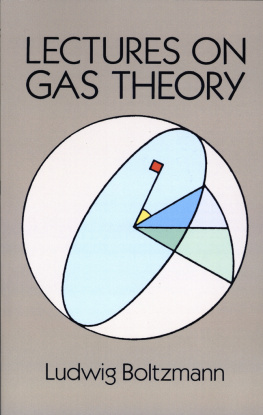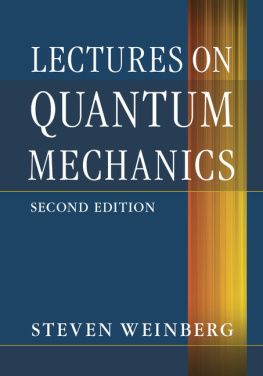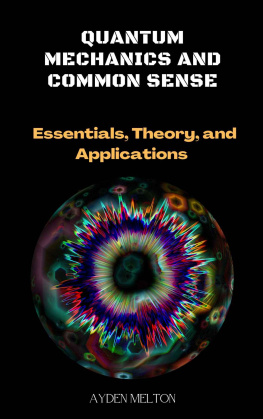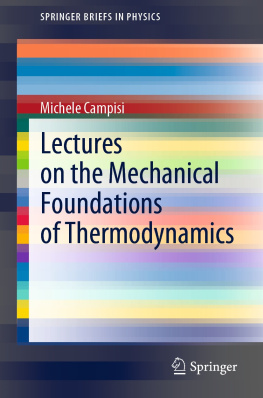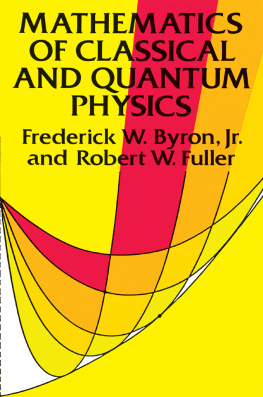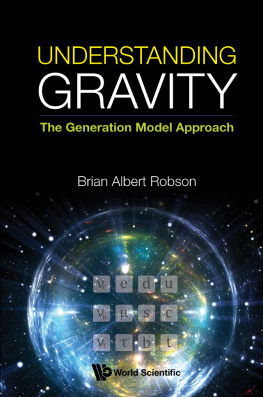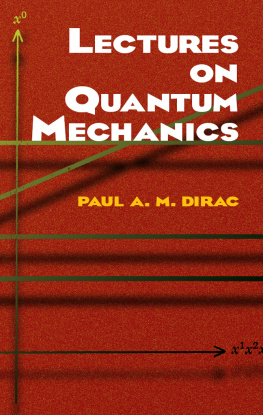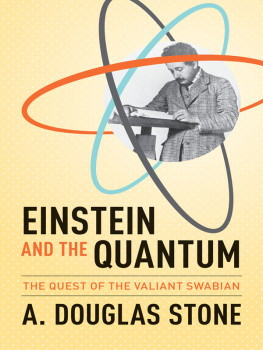LECTURES ON GAS THEORY
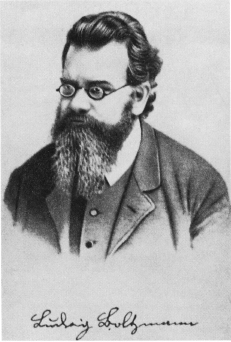
LECTURES ON GAS THEORY
Ludwig Boltzmann
Translated by Stephen G. Brush
DOVER PUBLICATIONS, INC.
NEW YORK
Copyright
Copyright 1964 by The Regents of the University of California.
All rights reserve.
Bibliographical Note
This Dover edition, first published in 1995, is an unabridged, unaltered republication of the English translation originally published by the University of California Press, Berkeley, 1964. The original work, in German, was published in two parts by J. A. Barth, Leipzig, Germany, 1896 (Part I) and 1898 (Part II), under the title Vorlesungen ber Gastheorie.
The Dover edition is published by special arrangement with the University of California Press, 2120 Berkeley Way, Berkeley, California 94720.
This translation was originally published with the assistance of a grant from the National Science Foundation.
Library of Congress Cataloging-in-Publication Data
Boltzmann, Ludwig, 1844-1906.
[Vorlesungen ber Gastheorie. English]
Lectures on gas theory / Ludwig Boltzmann ; translated by Stephen G. Brush. Dover ed.
p. cm.
Originally published: Berkeley : University of California Press, 1964.
Includes bibliographical references and index.
ISBN 0-486-68455-5
1. Kinetic theory of gases. I. Title.
QC175.B7213 1995
533.7dc20
94-41221
CIP
Manufactured in the United States by Courier Corporation
68455503
www.doverpublications.com
TRANSLATORS INTRODUCTION
Gas Theory
Boltzmanns Lectures on Gas Theory is an acknowledged masterpiece of theoretical physics; aside from its historical importance, it still has considerable scientific value today. It contains a comprehensive exposition of the kinetic theory of gases by a scientist who devoted a large part of his own career to it, and brought it very nearly to completion as a fundamental part of modern physics. The many physicists who are already familiar with Gastheorie in the original German edition (18961898) will not need this Introduction to remind them of its stature. But perhaps some scientists who scarcely have time to keep up with the latest publications in their subject may want to know why they should bother to read a book published more than 60 years ago; and a brief account of the place of the book in the development of modern physics may be of interest.
Ludwig Boltzmann (18441906) played a leading role in the nineteenth-century movement toward reducing the phenomena of heat, light, electricity, and magnetism to matter and motion in other words, to atomic models based on Newtonian mechanics. His own greatest contribution was to show how that mechanics, which had previously been regarded as deterministic and reversible in time, could be used to describe irreversible phenomena in the real world on a statistical basis. His original papers on the statistical interpretation of thermodynamics, the H-theorem, transport theory, thermal equilibrium, the equation of state of gases, and similar subjects, occupy about 2,000 pages in the proceedings of the Vienna Academy and other societies. While some of his discoveries attracted considerable attention and controversy in his own time, not even the handful of experts on kinetic theory could claim to have read everything he wrote. Realizing that few scientists of later generations were likely to study his long original memoirs in detail, Boltzmann decided to publish his lectures, in which the most important parts of the theory, including his own contributions, were carefully explained. In addition, he included his mature reflections and speculations Boltzmann summarized most (but not all) of his work in a two volume treatise Vorlesungen ber Gastheorie. This is one of the greatest books in the history of exact sciences and the reader is strongly advised to consult it. It is tough going but the rewards are great.
The modern reader will rightly assume that some parts of Boltzmanns theory must have been rendered obsolete by later discoveries. In particular, we know that one cannot expect to develop an adequate theory of atomic phenomena without using quantum mechanics. However, it turns out that almost all the properties of gases at ordinary temperatures and densities can be described by the classical theory developed in the nineteenth century, and for this reason there has been a considerable revival of interest in classical kinetic theory during the last few years, in connection with rarified gas dynamics, plasma physics, and neutron transport theory. The reason why the classical theory works is that, while the internal structure of molecules must be described by quantum mechanics, the interaction between two molecules can be fairly well described by a classical model which ignores this structure and simply uses a postulated force law whose parameters can be chosen to fit experimental data. Aside from phenomena at very high densities or very low temperatures, the only property that the classical theory fails to account for is the ratio of specific heats. However, this failure was already well known at the time Boltzmann wrote this book, and he is therefore quite cautious on this point. He simply concludes that for some unknown reason all the possible internal motions of a molecule do not have an equal share in the total energy, and takes this into account as an empirical fact.
As for various questions of a more fundamental nature, such as the relation between entropy and the direction of time, quantum theory has thrown new light on these problems but has not solved them. Boltzmanns remarks are therefore still of interest. Thus Hans Reichenbach proposes to define the direction of increasing time as the direction in which entropy increases, so that in a universe in which entropy fluctuates,
we cannot speak of a direction of time as a whole; only certain sections of time have directions, and these directions are not the same. The first to have the courage to draw this conclusion was Ludwig Boltzmann [Gas Theory,
The only respects in which the book may be considered out of date are, first, the emphasis on the inverse fifth-power repulsive force model for calculating transport properties, and, second, the molecular model used to explain dissociation phenomena. The reason for choosing the inverse fifth-power force law was that Maxwell (1866)on parts of their surfaces, is an interesting historical curiosity, but the need for such ad hoc assumptions to explain the directional character of chemical bonds has been eliminated by quantum mechanics.
History of the kinetic theory
The development of the kinetic theory of gases has been discussed at length elsewhere so only a brief summary will be given here.
The modern concept of air as a fluid exerting mechanical pressure on surfaces in contact with it goes back to the early seventeenth century, when Torricelli, Pascal, and Boyle first established the physical nature of the air. By a combination of experiments and theoretical reasoning they persuaded other scientists that the earth is surrounded by a sea of air that exerts pressure in much the same way that water does, and that air pressure is responsible for many of the phenomena previously attributed to natures abhorrence of a vacuum. We may view this development of the concept of air pressure as part of the change in scientific attitudes which led to the mechanico-corpuscular view of nature, associated with the names of Galileo, Boyle, Newton, and others. Instead of postulating occult forces or teleological principles to explain natural phenomena, scientists started to look for explanations based simply on matter and motion.
Next page
